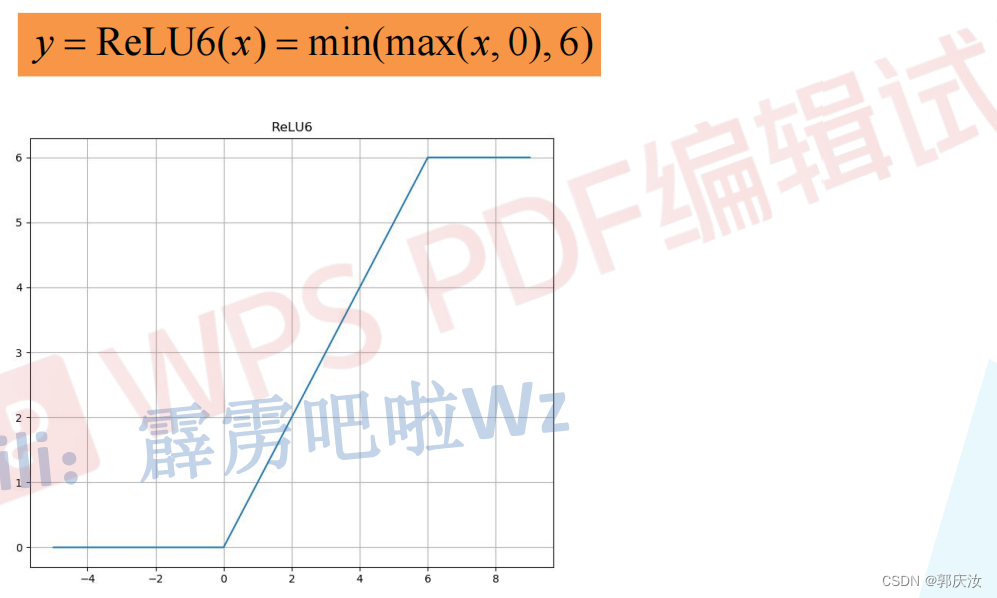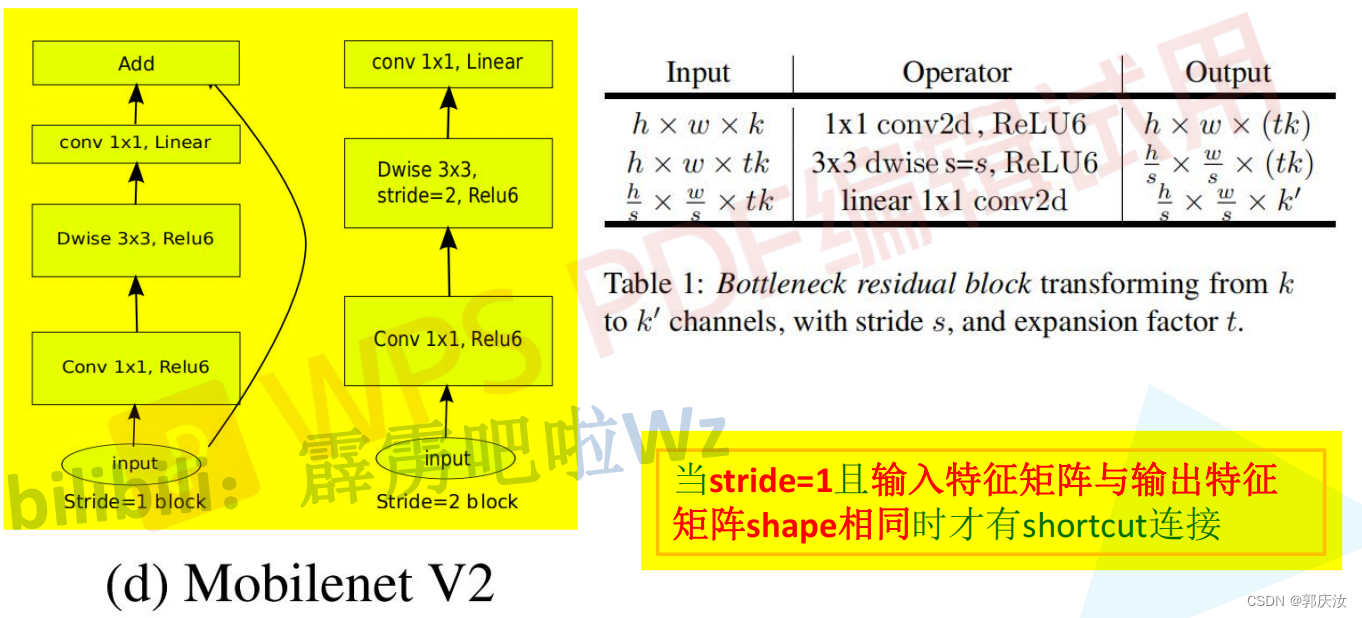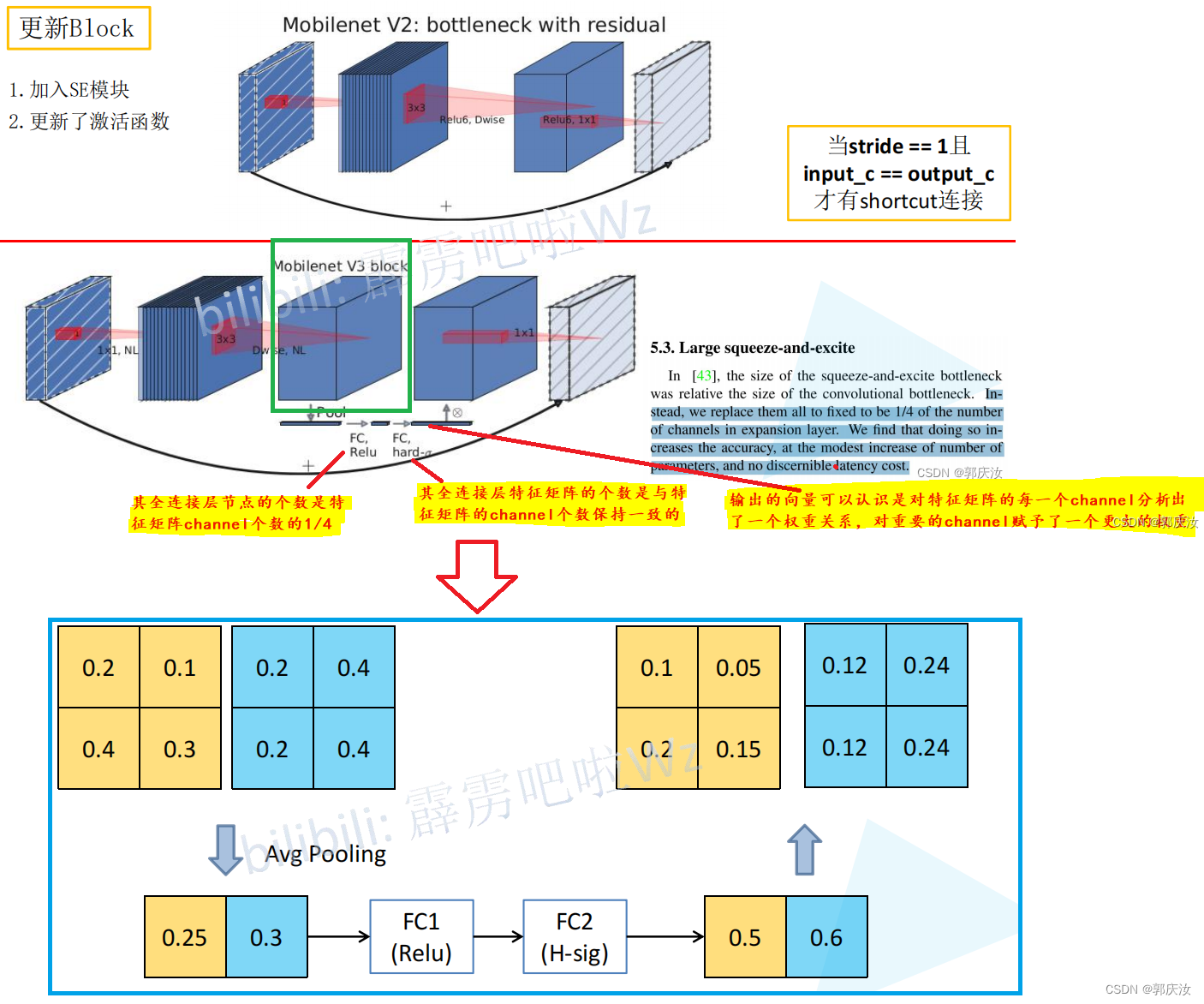深度学习网络模型 MobileNet系列MobileNet V1、MobileNet V2、MobileNet V3网络详解以及pytorch代码复现_mobilenetv3-程序员宅基地
技术标签: 深度学习 pytorch MobileNet V2 MobileNet V1 MobileNet V3
深度学习网络模型 MobileNet系列MobileNet V1、MobileNet V2、MobileNet V3网络详解以及pytorch代码复现



1、DW卷积与普通卷积计算量对比
DW与PW计算量
普通卷积计算量
计算量对比
因此理论上普通卷积是DW+PW卷积的8到9倍
2、MobileNet V1
MobileNet V1网络结构
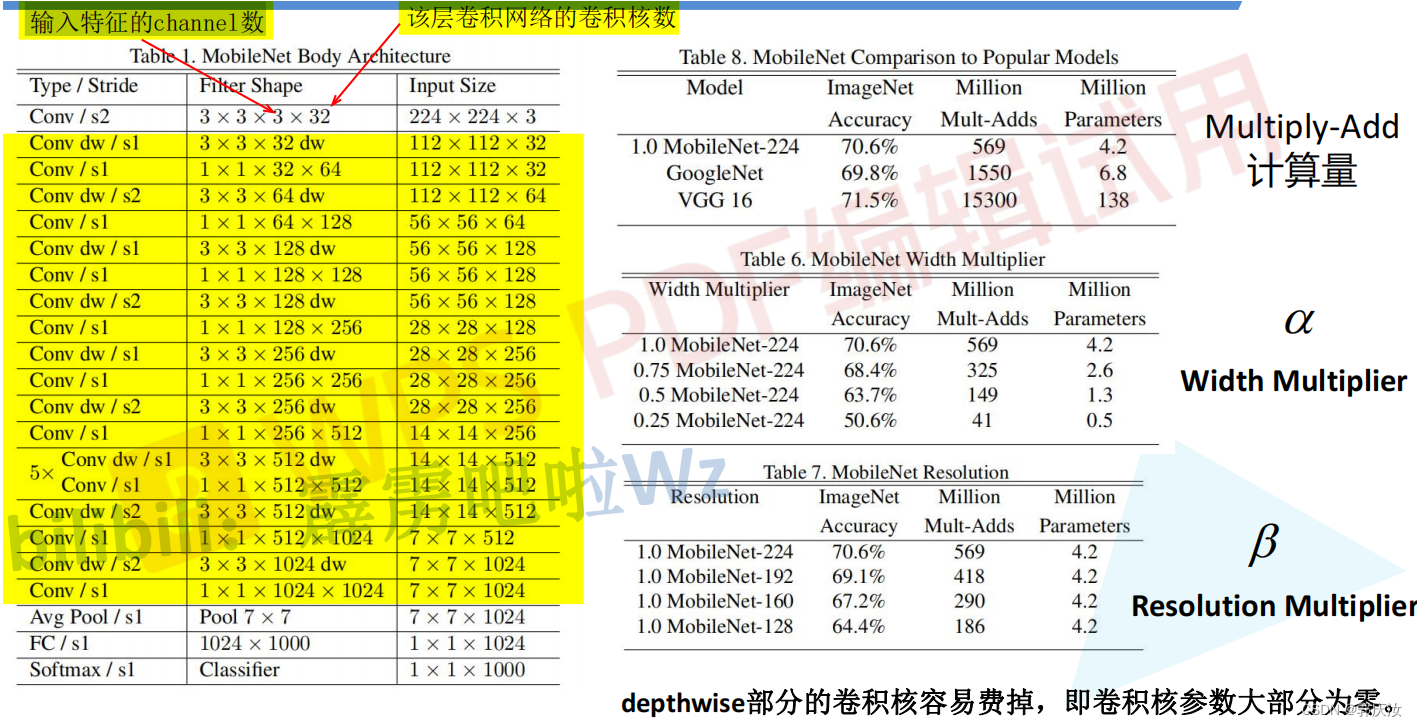
MobileNet V1网络结构代码
import torch.nn as nn
import torch
class MobileNetV1(nn.Module):
def __init__(self, ch_in, n_classes):
super(MobileNetV1, self).__init__()
# 定义普通卷积、BN、激活模块
def conv_bn(inp, oup, stride):
return nn.Sequential(
nn.Conv2d(inp, oup, 3, stride, 1, bias=False),
nn.BatchNorm2d(oup),
nn.ReLU(inplace=True)
)
# 定义DW、PW卷积模块
def conv_dw(inp, oup, stride):
return nn.Sequential(
# dw
nn.Conv2d(inp, inp, 3, stride, 1, groups=inp, bias=False), # DW卷积的卷积核输入与输出的数量一致,且等于分组数
nn.BatchNorm2d(inp),
nn.ReLU(inplace=True),
# pw
nn.Conv2d(inp, oup, 1, 1, 0, bias=False),
nn.BatchNorm2d(oup),
nn.ReLU(inplace=True),
)
self.model = nn.Sequential(
conv_bn(ch_in, 32, 2),
conv_dw(32, 64, 1),
conv_dw(64, 128, 2),
conv_dw(128, 128, 1),
conv_dw(128, 256, 2),
conv_dw(256, 256, 1),
conv_dw(256, 512, 2),
conv_dw(512, 512, 1),
conv_dw(512, 512, 1),
conv_dw(512, 512, 1),
conv_dw(512, 512, 1),
conv_dw(512, 512, 1),
conv_dw(512, 1024, 2),
conv_dw(1024, 1024, 1),
nn.AdaptiveAvgPool2d(1)
)
self.fc = nn.Linear(1024, n_classes)
def forward(self, x):
x = self.model(x)
x = x.view(-1, 1024)
x = self.fc(x)
return x
if __name__=='__main__':
# model check
model = MobileNetV1(ch_in=3, n_classes=5)
print(model)
random_data=torch.rand([1,3,224,224])
result = model(random_data)
print(result)
3、MobileNet V2
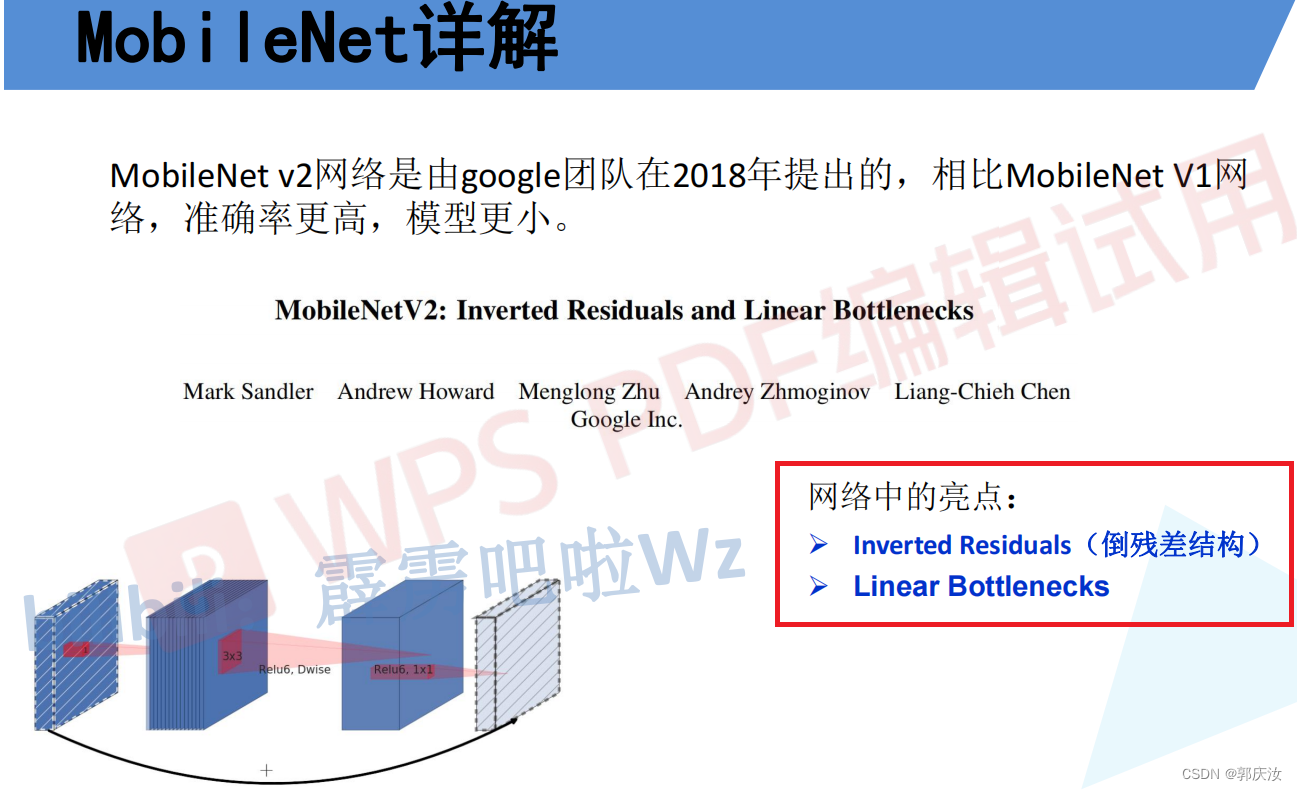
倒残差结构模块

Residual blok与Inverted residual block对比:
- Residual blok:先采用1 x 1的卷积核来对特征矩阵进行压缩,减少输入特征矩阵的channel,再通过3 x 3的卷积核进行特征处理,再采用1 x 1的卷积核来扩充channel维度,形成了两头大中间小的瓶颈结构。并且3 x 3的卷积后面采用Relu激活函数。
- Inverted residual block:先采用1 x 1的卷积核进行升高channel维度的操作,通过卷积核大小为3 x 3的DW模块进行卷积,再通过1 x 1的卷积进行降低channel维度的处理,形成两头小中间大的结构。并且3 x 3的卷积后面采用Relu6激活函数。
- Relu6激活函数
- 倒残差结构详细示意图
倒残差模块代码
# 定义普通卷积、BN结构
class ConvBNReLU(nn.Sequential):
def __init__(self, in_channel, out_channel, kernel_size=3, stride=1, groups=1):
padding = (kernel_size - 1) // 2 # padding的设置根据kernel_size来定,如果kernel_size为3,则padding设置为1;如果kernel_size为1,为padding为0
super(ConvBNReLU, self).__init__(
# 在pytorch中,如果设置的 group=1的话,就为普通卷积;如果设置的值为输入特征矩阵的深度的话(即in_channel),则为深度卷积(deptwise conv),并且Dw卷积的输出特征矩阵的深度等于输入特征矩阵的深度
nn.Conv2d(in_channel, out_channel, kernel_size, stride, padding, groups=groups, bias=False), # groups=1,表示普通的卷积;因为接下来要使用的是BN层,此处的偏置不起任何作用,所以设置为1
nn.BatchNorm2d(out_channel),
nn.ReLU6(inplace=True) # 此处使用的是Relu6激活函数
)
# 定义mobile网络基本结构--即到残差结构
class InvertedResidual(nn.Module):
def __init__(self, in_channel, out_channel, stride, expand_ratio):
super(InvertedResidual, self).__init__()
hidden_channel = in_channel * expand_ratio
self.use_shortcut = stride == 1 and in_channel == out_channel # stride == 1 and in_channel == out_channel:保证输入矩阵与输出矩阵的shape一致,且通道数也一致,这样才可以进行shurtcut
layers = []
if expand_ratio != 1: # 表示如果扩展因子不为1时,则使用1x1的卷积层(即对输入特征矩阵的深度进行扩充)
# 1x1 pointwise conv
layers.append(ConvBNReLU(in_channel, hidden_channel, kernel_size=1))
layers.extend([
# 3x3 depthwise conv
# 在pytorch中,如果设置的 group=1的话,就为普通卷积;如果设置的值为输入特征矩阵的深度的话(即in_channel),则为深度卷积(deptwise conv),并且Dw卷积的输出特征矩阵的深度等于输入特征矩阵的深度
ConvBNReLU(hidden_channel, hidden_channel, stride=stride, groups=hidden_channel),
# 1x1 pointwise conv(linear) 因为其后跟随的是线性激活函数,即y=x,所以其后面不在跟随激活函数
nn.Conv2d(hidden_channel, out_channel, kernel_size=1, bias=False),
nn.BatchNorm2d(out_channel),
])
self.conv = nn.Sequential(*layers)
def forward(self, x):
if self.use_shortcut:
return x + self.conv(x)
else:
return self.conv(x)
MobileNet V2详细网络结构
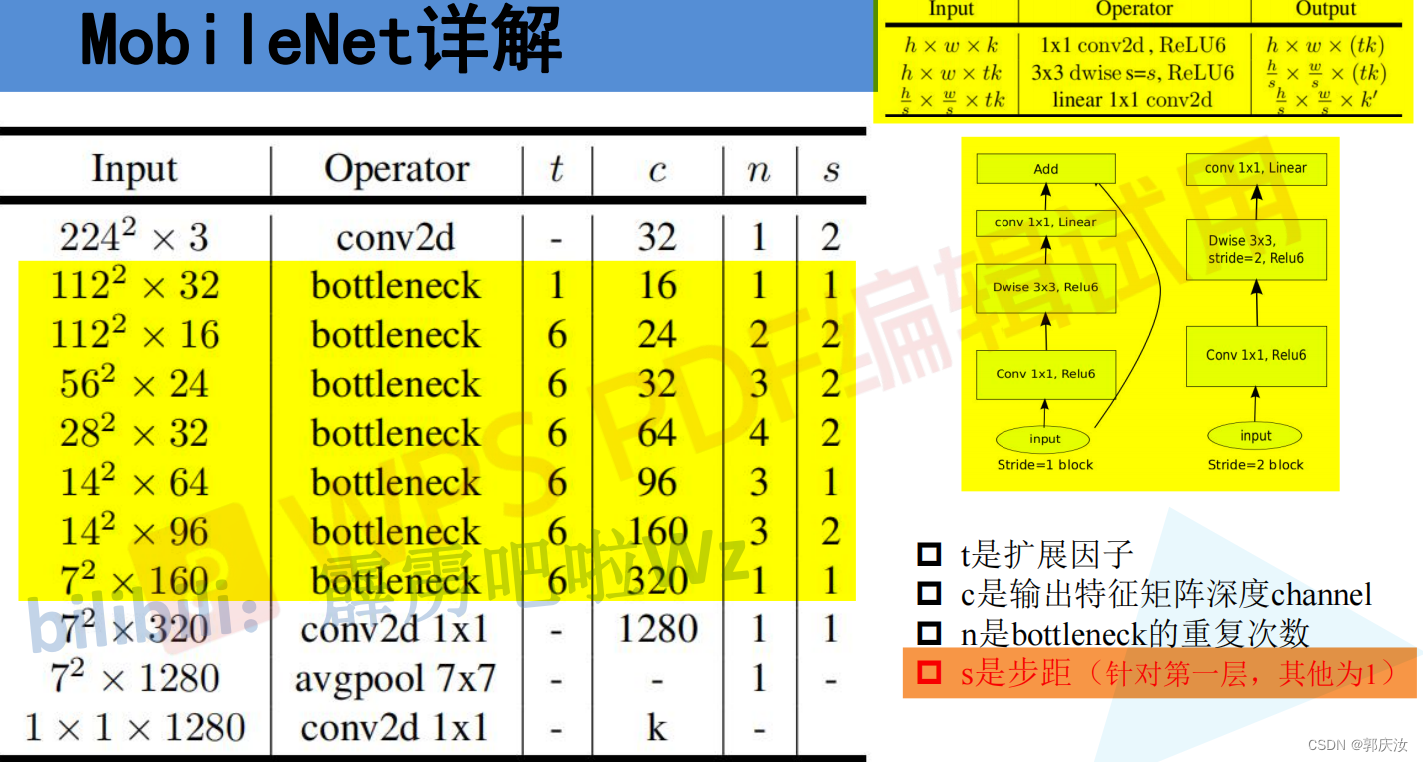
MobileNet V2网络结构代码
from torch import nn
import torch
def _make_divisible(ch, divisor=8, min_ch=None):
"""
将输入的通道数(ch)调整到divisor的整数倍,方便硬件加速
This function is taken from the original tf repo.
It ensures that all layers have a channel number that is divisible by 8
It can be seen here:
https://github.com/tensorflow/models/blob/master/research/slim/nets/mobilenet/mobilenet.py
"""
if min_ch is None:
min_ch = divisor
new_ch = max(min_ch, int(ch + divisor / 2) // divisor * divisor)
# Make sure that round down does not go down by more than 10%.
if new_ch < 0.9 * ch:
new_ch += divisor
return new_ch
# 定义普通卷积、BN结构
class ConvBNReLU(nn.Sequential):
def __init__(self, in_channel, out_channel, kernel_size=3, stride=1, groups=1):
padding = (kernel_size - 1) // 2 # padding的设置根据kernel_size来定,如果kernel_size为3,则padding设置为1;如果kernel_size为1,为padding为0
super(ConvBNReLU, self).__init__(
# 在pytorch中,如果设置的 group=1的话,就为普通卷积;如果设置的值为输入特征矩阵的深度的话(即in_channel),则为深度卷积(deptwise conv),并且Dw卷积的输出特征矩阵的深度等于输入特征矩阵的深度
nn.Conv2d(in_channel, out_channel, kernel_size, stride, padding, groups=groups, bias=False), # groups=1,表示普通的卷积;因为接下来要使用的是BN层,此处的偏置不起任何作用,所以设置为1
nn.BatchNorm2d(out_channel),
nn.ReLU6(inplace=True) # 此处使用的是Relu6激活函数
)
# 定义mobile网络基本结构--即到残差结构
class InvertedResidual(nn.Module):
def __init__(self, in_channel, out_channel, stride, expand_ratio):
super(InvertedResidual, self).__init__()
hidden_channel = in_channel * expand_ratio
self.use_shortcut = stride == 1 and in_channel == out_channel # stride == 1 and in_channel == out_channel:保证输入矩阵与输出矩阵的shape一致,且通道数也一致,这样才可以进行shurtcut
layers = []
if expand_ratio != 1: # 表示如果扩展因子不为1时,则使用1x1的卷积层(即对输入特征矩阵的深度进行扩充)
# 1x1 pointwise conv
layers.append(ConvBNReLU(in_channel, hidden_channel, kernel_size=1))
layers.extend([
# 3x3 depthwise conv
# 在pytorch中,如果设置的 group=1的话,就为普通卷积;如果设置的值为输入特征矩阵的深度的话(即in_channel),则为深度卷积(deptwise conv),并且Dw卷积的输出特征矩阵的深度等于输入特征矩阵的深度
ConvBNReLU(hidden_channel, hidden_channel, stride=stride, groups=hidden_channel),
# 1x1 pointwise conv(linear) 因为其后跟随的是线性激活函数,即y=x,所以其后面不在跟随激活函数
nn.Conv2d(hidden_channel, out_channel, kernel_size=1, bias=False),
nn.BatchNorm2d(out_channel),
])
self.conv = nn.Sequential(*layers)
def forward(self, x):
if self.use_shortcut:
return x + self.conv(x)
else:
return self.conv(x)
# 定义mobileNetV2网络
class MobileNetV2(nn.Module):
def __init__(self, num_classes=1000, alpha=1.0, round_nearest=8):
super(MobileNetV2, self).__init__()
block = InvertedResidual
input_channel = _make_divisible(32 * alpha, round_nearest) # 将卷积核的个数调整为8的整数倍
last_channel = _make_divisible(1280 * alpha, round_nearest)
inverted_residual_setting = [
# t, c, n, s
[1, 16, 1, 1],
[6, 24, 2, 2],
[6, 32, 3, 2],
[6, 64, 4, 2],
[6, 96, 3, 1],
[6, 160, 3, 2],
[6, 320, 1, 1],
]
features = []
# conv1 layer
features.append(ConvBNReLU(3, input_channel, stride=2)) # 添加第一层普通卷积层
# building inverted residual residual blockes
for t, c, n, s in inverted_residual_setting:
output_channel = _make_divisible(c * alpha, round_nearest) # 根据alpha因子调整卷积核的个数
for i in range(n): # 循环添加倒残差模块
stride = s if i == 0 else 1 # s表示的是倒残差模块结构中第一层卷积对应的步距,剩余层都是1
features.append(block(input_channel, output_channel, stride, expand_ratio=t)) # 添加一系列倒残差结构
input_channel = output_channel
# building last several layers
features.append(ConvBNReLU(input_channel, last_channel, 1)) # 构建最后一层卷积层
# combine feature layers
self.features = nn.Sequential(*features)
# building classifier
self.avgpool = nn.AdaptiveAvgPool2d((1, 1)) # 采用自适应平均采样层
self.classifier = nn.Sequential(
nn.Dropout(0.2),
nn.Linear(last_channel, num_classes)
)
# weight initialization 初始化全只能怪
for m in self.modules():
if isinstance(m, nn.Conv2d):
nn.init.kaiming_normal_(m.weight, mode='fan_out')
if m.bias is not None:
nn.init.zeros_(m.bias)
elif isinstance(m, nn.BatchNorm2d):
nn.init.ones_(m.weight)
nn.init.zeros_(m.bias)
elif isinstance(m, nn.Linear):
nn.init.normal_(m.weight, 0, 0.01) # 初始化为正态分布的函数,均值为0,方差为0.01
nn.init.zeros_(m.bias)
def forward(self, x):
x = self.features(x)
x = self.avgpool(x)
x = torch.flatten(x, 1)
x = self.classifier(x)
return x
if __name__ == '__main__':
divisible = _make_divisible(1)
print(divisible)
4、MobileNet V3
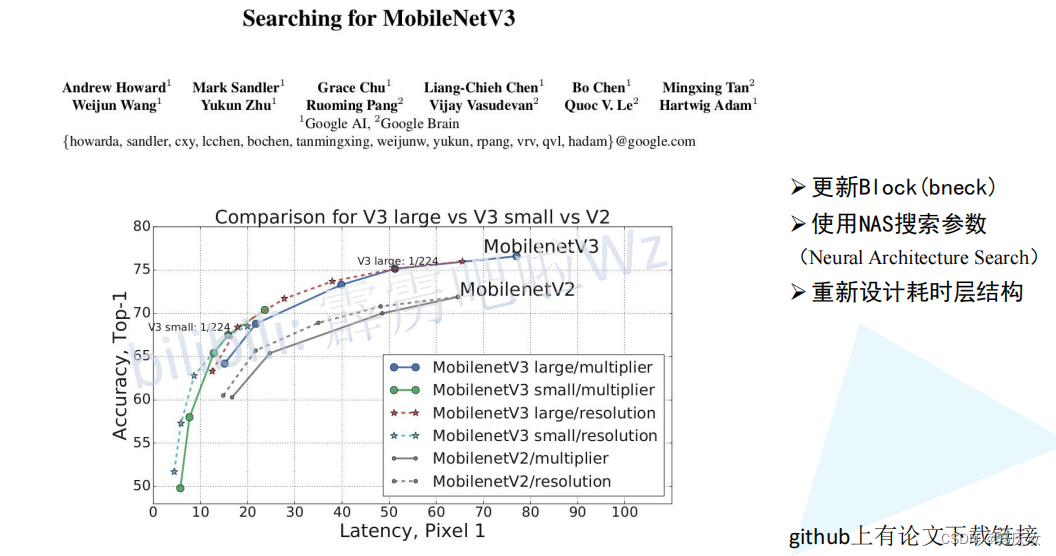
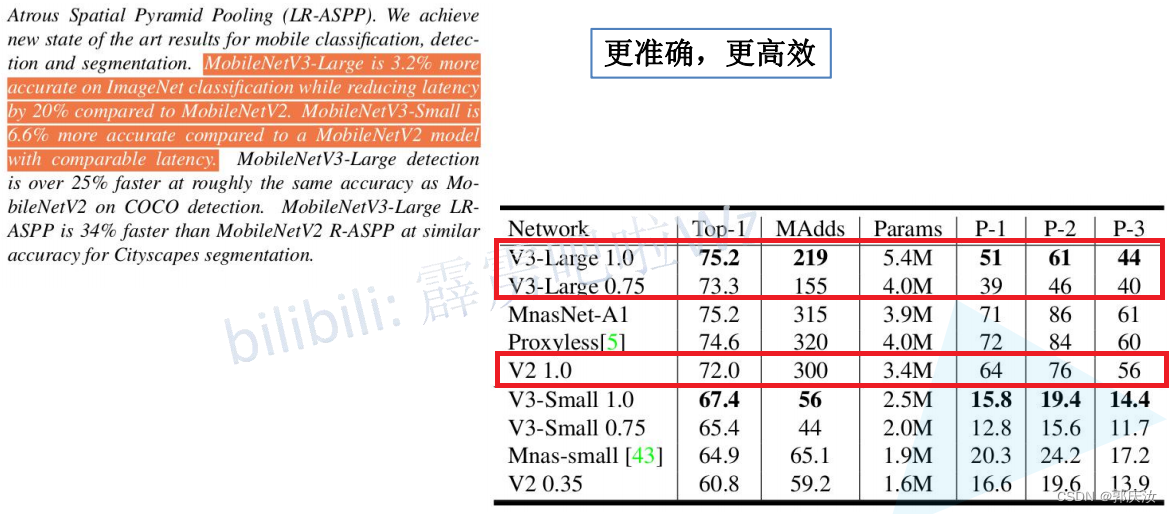
创新点
- 加入了注意力机制SE模块
- 使用的新的激活函数
- 激活函数
MobileNet V3详细网络结构
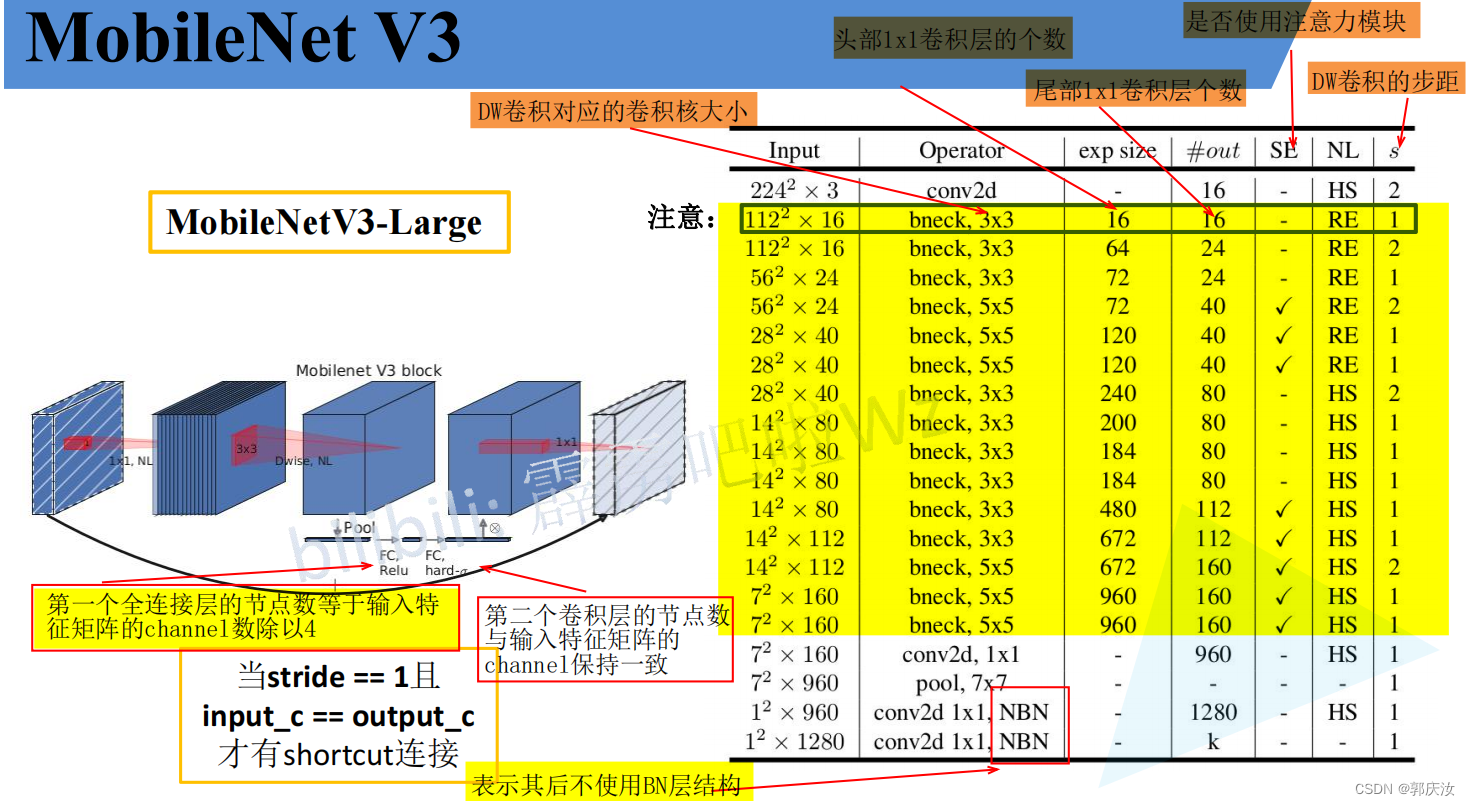
# 定义block的配置类
class InvertedResidualConfig:
def __init__(self,
input_c: int, # block模块中的第一个1x1卷积层的输入channel数
kernel: int, # depthwise卷积的卷积核大小
expanded_c: int, # block模块中的第一个1x1卷积层的输出channel数
out_c: int, # 经过block模块中第二个1x1卷积层处理过后得到的channel数
use_se: bool, # 是否使用注意力机制模块
activation: str, # 激活方式
stride: int, # 步长
width_multi: float): # width_multi:调节每个卷积层所使用channel的倍率因子
self.input_c = self.adjust_channels(input_c, width_multi)
self.kernel = kernel
self.expanded_c = self.adjust_channels(expanded_c, width_multi)
self.out_c = self.adjust_channels(out_c, width_multi)
self.use_se = use_se
self.use_hs = activation == "HS" # whether using h-swish activation
self.stride = stride
@staticmethod
def adjust_channels(channels: int, width_multi: float):
return _make_divisible(channels * width_multi, 8)
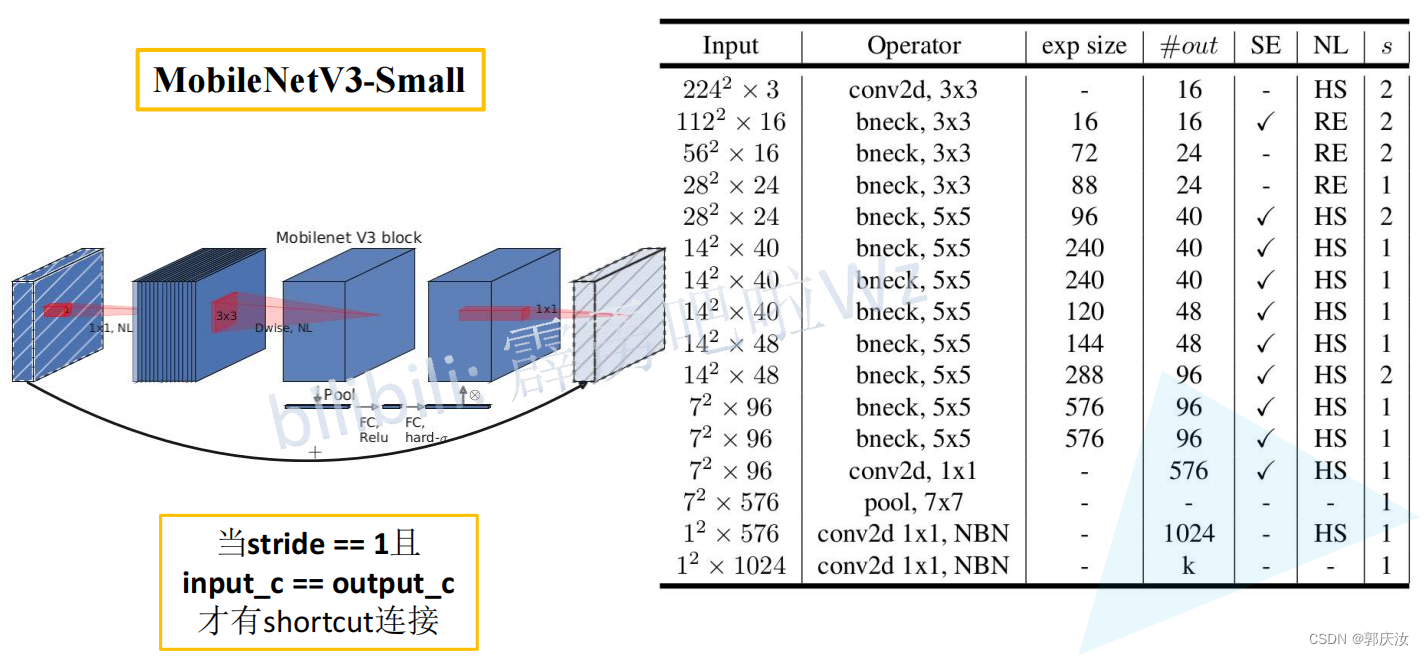
注意力机制SE模块代码
# 注意力机制模块(SE模块,即两个全连接层) 该模块的基本流程是:先进行自适应平均池化(1x1)———>1x1的卷积层———>relu激活层———>1x1的卷积池化———>hardsigmoid()激活函数激活
class SqueezeExcitation(nn.Module):
def __init__(self, input_c: int, squeeze_factor: int = 4):
super(SqueezeExcitation, self).__init__()
squeeze_c = _make_divisible(input_c // squeeze_factor, 8) # 获得距离该数最近的8的整数倍的数字
self.fc1 = nn.Conv2d(input_c, squeeze_c, 1) # 该卷积的输出的squeeze_c是输入input_c的1/4
self.fc2 = nn.Conv2d(squeeze_c, input_c, 1)
def forward(self, x: Tensor) -> Tensor:
scale = F.adaptive_avg_pool2d(x, output_size=(1, 1)) # 将特征矩阵每一个channel上的数据给平均池化到1x1的大小
scale = self.fc1(scale)
scale = F.relu(scale, inplace=True)
scale = self.fc2(scale)
scale = F.hardsigmoid(scale, inplace=True) # 激活函数
return scale * x # 将得到的数据与传入的对应channel数据进行相乘
InvertedResidual模块代码
# 定义block模块
# 此为block模块,其包含第一个1x1卷积层、DeptWis卷积层、SE注意力机制层(判断是否需求)、第二个1x1卷积层、激活函数(需要判断是否是非线性激活)
class InvertedResidual(nn.Module):
def __init__(self,
cnf: InvertedResidualConfig, # cnf:配置类参数
norm_layer: Callable[..., nn.Module]): # norm_layer:# BN层
super(InvertedResidual, self).__init__()
if cnf.stride not in [1, 2]: # 判断某一层的配置文件,其步长是否满足条件
raise ValueError("illegal stride value.")
# 判断是否进行短连接
self.use_res_connect = (cnf.stride == 1 and cnf.input_c == cnf.out_c) # 只有当步长为1,并且输入通道等于输出通道数
layers: List[nn.Module] = []
activation_layer = nn.Hardswish if cnf.use_hs else nn.ReLU # 判断当前的激活函数类型
# expand
# 判断是否相等,如果相等,则不适用1x1的卷积层增加channel维度;不相等的话,才使用该层进行升维度
if cnf.expanded_c != cnf.input_c:
layers.append(ConvBNActivation(cnf.input_c,
cnf.expanded_c,
kernel_size=1,
norm_layer=norm_layer,
activation_layer=activation_layer))
# depthwise
layers.append(ConvBNActivation(cnf.expanded_c,
cnf.expanded_c,
kernel_size=cnf.kernel, # depthwise卷积的卷积核大小
stride=cnf.stride,
groups=cnf.expanded_c,
norm_layer=norm_layer, # BN层
activation_layer=activation_layer))
# 判断是否需要添加SE模块
if cnf.use_se:
layers.append(SqueezeExcitation(cnf.expanded_c))
# project
layers.append(ConvBNActivation(cnf.expanded_c,
cnf.out_c,
kernel_size=1,
norm_layer=norm_layer, # BN 层
activation_layer=nn.Identity)) # 此层的activation_layer就是进行里普通的线性激活,没有做任何的处理
self.block = nn.Sequential(*layers)
self.out_channels = cnf.out_c
self.is_strided = cnf.stride > 1
def forward(self, x: Tensor) -> Tensor:
result = self.block(x)
if self.use_res_connect:
result += x # 进行shortcut连接
return result
整体代码
from typing import Callable, List, Optional
import torch
from torch import nn, Tensor
from torch.nn import functional as F
from functools import partial
# 得到同传入数据最近的8的整数倍数值
def _make_divisible(ch, divisor=8, min_ch=None):
"""
This function is taken from the original tf repo.
It ensures that all layers have a channel number that is divisible by 8
It can be seen here:
https://github.com/tensorflow/models/blob/master/research/slim/nets/mobilenet/mobilenet.py
"""
if min_ch is None:
min_ch = divisor
new_ch = max(min_ch, int(ch + divisor / 2) // divisor * divisor)
# Make sure that round down does not go down by more than 10%.
if new_ch < 0.9 * ch:
new_ch += divisor
return new_ch
# 普通卷积、BN、激活层模块
class ConvBNActivation(nn.Sequential):
def __init__(self,
in_planes: int, # 输入特征矩阵的通道
out_planes: int, # 输出特征矩阵的通道
kernel_size: int = 3,
stride: int = 1,
groups: int = 1,
norm_layer: Optional[Callable[..., nn.Module]] = None, # 在卷积后的BN层
activation_layer: Optional[Callable[..., nn.Module]] = None): # 激活函数
padding = (kernel_size - 1) // 2
if norm_layer is None:
norm_layer = nn.BatchNorm2d
if activation_layer is None:
activation_layer = nn.ReLU6
super(ConvBNActivation, self).__init__(nn.Conv2d(in_channels=in_planes,
out_channels=out_planes,
kernel_size=kernel_size,
stride=stride,
padding=padding,
groups=groups,
bias=False),
norm_layer(out_planes), # BN层
activation_layer(inplace=True))
# 注意力机制模块(SE模块,即两个全连接层) 该模块的基本流程是:先进行自适应平均池化(1x1)———>1x1的卷积层———>relu激活层———>1x1的卷积池化———>hardsigmoid()激活函数激活
class SqueezeExcitation(nn.Module):
def __init__(self, input_c: int, squeeze_factor: int = 4):
super(SqueezeExcitation, self).__init__()
squeeze_c = _make_divisible(input_c // squeeze_factor, 8) # 获得距离该数最近的8的整数倍的数字
self.fc1 = nn.Conv2d(input_c, squeeze_c, 1) # 该卷积的输出的squeeze_c是输入input_c的1/4 其作用与全连接层一样
self.fc2 = nn.Conv2d(squeeze_c, input_c, 1)
def forward(self, x: Tensor) -> Tensor:
scale = F.adaptive_avg_pool2d(x, output_size=(1, 1)) # 将特征矩阵每一个channel上的数据给平均池化到1x1的大小
scale = self.fc1(scale)
scale = F.relu(scale, inplace=True)
scale = self.fc2(scale)
scale = F.hardsigmoid(scale, inplace=True) # 激活函数
return scale * x # 将得到的数据与传入的对应channel数据进行相乘
# 定义block的配置类
class InvertedResidualConfig:
def __init__(self,
input_c: int, # block模块中的第一个1x1卷积层的输入channel数
kernel: int, # depthwise卷积的卷积核大小
expanded_c: int, # block模块中的第一个1x1卷积层的输出channel数
out_c: int, # 经过block模块中第二个1x1卷积层处理过后得到的channel数
use_se: bool, # 是否使用注意力机制模块
activation: str, # 激活方式
stride: int, # 步长
width_multi: float): # width_multi:调节每个卷积层所使用channel的倍率因子
self.input_c = self.adjust_channels(input_c, width_multi)
self.kernel = kernel
self.expanded_c = self.adjust_channels(expanded_c, width_multi)
self.out_c = self.adjust_channels(out_c, width_multi)
self.use_se = use_se
self.use_hs = activation == "HS" # whether using h-swish activation
self.stride = stride
@staticmethod
def adjust_channels(channels: int, width_multi: float):
return _make_divisible(channels * width_multi, 8)
# 定义block模块
# 此为block模块,其包含第一个1x1卷积层、DeptWis卷积层、SE注意力机制层(判断是否需求)、第二个1x1卷积层、激活函数(需要判断是否是非线性激活)
class InvertedResidual(nn.Module):
def __init__(self,
cnf: InvertedResidualConfig, # cnf:配置类参数
norm_layer: Callable[..., nn.Module]): # norm_layer:# BN层
super(InvertedResidual, self).__init__()
if cnf.stride not in [1, 2]: # 判断某一层的配置文件,其步长是否满足条件
raise ValueError("illegal stride value.")
# 判断是否进行短连接
self.use_res_connect = (cnf.stride == 1 and cnf.input_c == cnf.out_c) # 只有当步长为1,并且输入通道等于输出通道数
layers: List[nn.Module] = []
activation_layer = nn.Hardswish if cnf.use_hs else nn.ReLU # 判断当前的激活函数类型
# expand
# 判断是否相等,如果相等,则不适用1x1的卷积层增加channel维度;不相等的话,才使用该层进行升维度
if cnf.expanded_c != cnf.input_c:
layers.append(ConvBNActivation(cnf.input_c,
cnf.expanded_c,
kernel_size=1,
norm_layer=norm_layer,
activation_layer=activation_layer))
# depthwise
layers.append(ConvBNActivation(cnf.expanded_c,
cnf.expanded_c,
kernel_size=cnf.kernel, # depthwise卷积的卷积核大小
stride=cnf.stride,
groups=cnf.expanded_c, # 深度DW卷积
norm_layer=norm_layer, # BN层
activation_layer=activation_layer))
# 判断是否需要添加SE模块
if cnf.use_se:
layers.append(SqueezeExcitation(cnf.expanded_c))
# project
layers.append(ConvBNActivation(cnf.expanded_c,
cnf.out_c,
kernel_size=1,
norm_layer=norm_layer, # BN 层
activation_layer=nn.Identity)) # 此层的activation_layer就是进行里普通的线性激活,没有做任何的处理
self.block = nn.Sequential(*layers)
self.out_channels = cnf.out_c
self.is_strided = cnf.stride > 1
def forward(self, x: Tensor) -> Tensor:
result = self.block(x)
if self.use_res_connect:
result += x # 进行shortcut连接
return result
# MobileNetV3网络结构基础框架:其包括:模型的第一层卷积层———>nx【bneckBlock模块】———>1x1的卷积层———>自适应平均池化层———>全连接层———>全连接层
class MobileNetV3(nn.Module):
def __init__(self,
inverted_residual_setting: List[InvertedResidualConfig], # beneckBlock结构一系列参数列表
last_channel: int, # 对应的是倒数第二个全连接层输出节点数 1280
num_classes: int = 1000, # 类别个数
block: Optional[Callable[..., nn.Module]] = None, # InvertedResidual核心模块
norm_layer: Optional[Callable[..., nn.Module]] = None):
super(MobileNetV3, self).__init__()
if not inverted_residual_setting:
raise ValueError("The inverted_residual_setting should not be empty.")
elif not (isinstance(inverted_residual_setting, List) and
all([isinstance(s, InvertedResidualConfig) for s in inverted_residual_setting])):
raise TypeError("The inverted_residual_setting should be List[InvertedResidualConfig]")
if block is None:
block = InvertedResidual # block类
if norm_layer is None:
norm_layer = partial(nn.BatchNorm2d, eps=0.001, momentum=0.01) # partial()为python方法,即为nn.BatchNorm2d传入默认的两个参数
layers: List[nn.Module] = []
# building first layer
# 构建第一层卷积结构
firstconv_output_c = inverted_residual_setting[0].input_c # 表示第一个卷积层输出的channel数
layers.append(ConvBNActivation(3, # 输入图像数据的channel数
firstconv_output_c, # 输出channel
kernel_size=3,
stride=2,
norm_layer=norm_layer,
activation_layer=nn.Hardswish))
# building inverted residual blocks
# 利用循环的方式添加block模块,将每层的配置文件传给block
for cnf in inverted_residual_setting:
layers.append(block(cnf, norm_layer))
# building last several layers
lastconv_input_c = inverted_residual_setting[-1].out_c # 最后的bneckblock的输出channel
lastconv_output_c = 6 * lastconv_input_c # lastconv_output_c 与 最后的bneckblock的输出channel数是六倍的关系
# 定义最后一层的卷积层
layers.append(ConvBNActivation(lastconv_input_c, # 最后的bneckblock的输出channel数
lastconv_output_c, # lastconv_output_c 与 最后的bneckblock的输出channel数是六倍的关系
kernel_size=1,
norm_layer=norm_layer,
activation_layer=nn.Hardswish))
self.features = nn.Sequential(*layers)
self.avgpool = nn.AdaptiveAvgPool2d(1)
self.classifier = nn.Sequential(nn.Linear(lastconv_output_c, last_channel),
nn.Hardswish(inplace=True),
nn.Dropout(p=0.2, inplace=True),
nn.Linear(last_channel, num_classes))
# initial weights
for m in self.modules():
if isinstance(m, nn.Conv2d):
nn.init.kaiming_normal_(m.weight, mode="fan_out")
if m.bias is not None:
nn.init.zeros_(m.bias)
elif isinstance(m, (nn.BatchNorm2d, nn.GroupNorm)):
nn.init.ones_(m.weight)
nn.init.zeros_(m.bias)
elif isinstance(m, nn.Linear):
nn.init.normal_(m.weight, 0, 0.01)
nn.init.zeros_(m.bias)
def _forward_impl(self, x: Tensor) -> Tensor:
x = self.features(x)
x = self.avgpool(x)
x = torch.flatten(x, 1)
x = self.classifier(x)
return x
def forward(self, x: Tensor) -> Tensor:
return self._forward_impl(x)
### 构建large基础mobilenet_v3_large模型
def mobilenet_v3_large(num_classes: int = 1000,
reduced_tail: bool = False) -> MobileNetV3:
"""
Constructs a large MobileNetV3 architecture from
"Searching for MobileNetV3" <https://arxiv.org/abs/1905.02244>.
weights_link:
https://download.pytorch.org/models/mobilenet_v3_large-8738ca79.pth
Args:
num_classes (int): number of classes
reduced_tail (bool): If True, reduces the channel counts of all feature layers
between C4 and C5 by 2. It is used to reduce the channel redundancy in the
backbone for Detection and Segmentation.
"""
width_multi = 1.0
bneck_conf = partial(InvertedResidualConfig, width_multi=width_multi)
adjust_channels = partial(InvertedResidualConfig.adjust_channels, width_multi=width_multi)
reduce_divider = 2 if reduced_tail else 1 # 是否较少网络参数标志,默认是False,即不减少
# # beneckBlock结构一系列参数列表
inverted_residual_setting = [
# input_c, kernel, expanded_c, out_c, use_se, activation, stride
bneck_conf(16, 3, 16, 16, False, "RE", 1),
bneck_conf(16, 3, 64, 24, False, "RE", 2), # C1
bneck_conf(24, 3, 72, 24, False, "RE", 1),
bneck_conf(24, 5, 72, 40, True, "RE", 2), # C2
bneck_conf(40, 5, 120, 40, True, "RE", 1),
bneck_conf(40, 5, 120, 40, True, "RE", 1),
bneck_conf(40, 3, 240, 80, False, "HS", 2), # C3
bneck_conf(80, 3, 200, 80, False, "HS", 1),
bneck_conf(80, 3, 184, 80, False, "HS", 1),
bneck_conf(80, 3, 184, 80, False, "HS", 1),
bneck_conf(80, 3, 480, 112, True, "HS", 1),
bneck_conf(112, 3, 672, 112, True, "HS", 1),
bneck_conf(112, 5, 672, 160 // reduce_divider, True, "HS", 2), # C4
bneck_conf(160 // reduce_divider, 5, 960 // reduce_divider, 160 // reduce_divider, True, "HS", 1),
bneck_conf(160 // reduce_divider, 5, 960 // reduce_divider, 160 // reduce_divider, True, "HS", 1),
]
last_channel = adjust_channels(1280 // reduce_divider) # C5
return MobileNetV3(inverted_residual_setting=inverted_residual_setting,
last_channel=last_channel,
num_classes=num_classes)
### 构建small基础mobilenet_v3_small模型
def mobilenet_v3_small(num_classes: int = 1000,
reduced_tail: bool = False) -> MobileNetV3:
"""
Constructs a large MobileNetV3 architecture from
"Searching for MobileNetV3" <https://arxiv.org/abs/1905.02244>.
weights_link:
https://download.pytorch.org/models/mobilenet_v3_small-047dcff4.pth
Args:
num_classes (int): number of classes
reduced_tail (bool): If True, reduces the channel counts of all feature layers
between C4 and C5 by 2. It is used to reduce the channel redundancy in the
backbone for Detection and Segmentation.
"""
width_multi = 1.0
bneck_conf = partial(InvertedResidualConfig, width_multi=width_multi)
adjust_channels = partial(InvertedResidualConfig.adjust_channels, width_multi=width_multi)
reduce_divider = 2 if reduced_tail else 1
inverted_residual_setting = [
# input_c, kernel, expanded_c, out_c, use_se, activation, stride
bneck_conf(16, 3, 16, 16, True, "RE", 2), # C1
bneck_conf(16, 3, 72, 24, False, "RE", 2), # C2
bneck_conf(24, 3, 88, 24, False, "RE", 1),
bneck_conf(24, 5, 96, 40, True, "HS", 2), # C3
bneck_conf(40, 5, 240, 40, True, "HS", 1),
bneck_conf(40, 5, 240, 40, True, "HS", 1),
bneck_conf(40, 5, 120, 48, True, "HS", 1),
bneck_conf(48, 5, 144, 48, True, "HS", 1),
bneck_conf(48, 5, 288, 96 // reduce_divider, True, "HS", 2), # C4
bneck_conf(96 // reduce_divider, 5, 576 // reduce_divider, 96 // reduce_divider, True, "HS", 1),
bneck_conf(96 // reduce_divider, 5, 576 // reduce_divider, 96 // reduce_divider, True, "HS", 1)
]
last_channel = adjust_channels(1024 // reduce_divider) # C5
return MobileNetV3(inverted_residual_setting=inverted_residual_setting,
last_channel=last_channel,
num_classes=num_classes)
pytorch代码复现MobileNet V1~V2
本项目包含训练MobileNet V1、V2、V2模型
项目目录
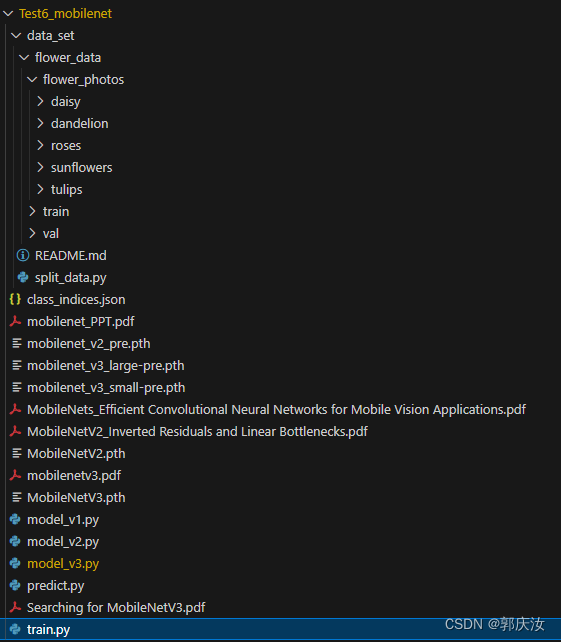
项目代码下载地址:
项目代码下载地址
智能推荐
vue3背景下,el-input嵌套在弹出框中,自动聚焦“失效”?如何实现自动聚焦_vue3 el-input 自动聚焦autofocus无效-程序员宅基地
文章浏览阅读436次,点赞15次,收藏2次。原因或许是,使用autofocus时,确实聚焦了!但是当我们又点击 显示弹出框的按钮时,input又失焦了,所以当我们看到input框时,没有自动聚焦。_vue3 el-input 自动聚焦autofocus无效
linux网络服务配置说课,《说课稿LINUX》PPT课件.ppt-程序员宅基地
文章浏览阅读222次。《《说课稿LINUX》PPT课件.ppt》由会员分享,可在线阅读,更多相关《《说课稿LINUX》PPT课件.ppt(16页珍藏版)》请在装配图网上搜索。1、LINUX 基础应用与配置管理 桂林山水职业学院计算机系 朱笑雷 主要内容 课程定位 1 课程内容设置 2 教学方法与手段 3 教材建设 4 教学团度 5 主要内容 实践条件 6 课程考核 7 教学效果 8 课程特色 9 建设思路 10 一、课..._linux说课课件
在SpringBoot中启动时关于连接数据库失败的问题_springboot启动时数据库连接失败 不关闭-程序员宅基地
文章浏览阅读2.2k次。#在SpringBoot中启动时关于连接数据库失败的问题对照了application.yml,发现配置文件貌似没什么问题,但是在查找信息之后,发现问题正是出现在application.yml中问题出于datasource下的data-username和data-password只要将data-username和data-password改为username和password即可..._springboot启动时数据库连接失败 不关闭
antd-pro(V5)动态菜单_antdpro的菜单-程序员宅基地
文章浏览阅读4.6k次。一般情况下登录系统后菜单是由后端返回的,不是前端写死的。antd-pro也支持,修改的路径在app.tsx在 layout 里加一个menuDataRender字段先给一个() =>[]可以看到左侧菜单没了,说明配置生效了,接下来就可以围绕这个配置做文章了,我们先定义一个 menuDataRender方法。根据登录缓存到本地的数据做下处理,判断菜单里要展示哪些内容(比如替换字段,隐藏不显示的菜单,隐藏按钮等),处理好了后返回一个数组结构即可。示例代码如下export const layout: _antdpro的菜单
Linux安装使用jprofiler6分析服务器应用状态-程序员宅基地
文章浏览阅读77次。为什么80%的码农都做不了架构师?>>> ..._jprofiler6 key
苏小红C语言第四版课后习题练习7.7最大公约数三种计算方式_c语言程序设计第四版课后题答案苏小红第七章-程序员宅基地
文章浏览阅读170次。(可以看出递归算法更加侧重于计算的技巧,并且计算机计算的次数也相对更少);_c语言程序设计第四版课后题答案苏小红第七章
随便推点
视频格式转换器榜单:10 款最值得拥有的高清视频转换器_奇客视频转换-程序员宅基地
文章浏览阅读560次。如果您想在计算机或任何其他设备上播放高质量的视频,高清视频转换器可以帮助确保您的视频与您的操作系统和硬件兼容。您还可以使用高清转换器更改视频的分辨率,无论您是想提高质量还是降低分辨率以生成更小的文件。在下表中,我们描述了用于转换高清视频的最流行和可用的桌面程序和在线服务。它们各有优缺点,因此请根据您的需要进行选择。_奇客视频转换
Unity血条效果,图片动画_游戏血条动图-程序员宅基地
文章浏览阅读1.9k次。欢迎来到unity学习、unity培训、unity企业培训教育专区,这里有很多U3D资源、U3D培训视频,我们致力于打造业内unity3d培训、学习第一品牌。今天开始做我们的游戏了,组长给分配了任务,我负责做剧情动画,人物血条和种植植物。 一、剧情动画 动画是以多个图片的形式展现的,图片是自己制作的。 private GUITextu_游戏血条动图
环境变量的加载顺序、环境变量集合_环境变量的顺序-程序员宅基地
文章浏览阅读1k次。*******字符编码ASCII,GB2312,GBK,Unicode,UTF-8比较参考:https://blog.csdn.net/softwarenb/article/details/51994943**环境变量的加载顺序:Mac系统的环境变量,加载顺序为:a. /etc/profileb. /etc/pathsc. ~/.bash_profiled. ~/..._环境变量的顺序
科学家发现让人类幸福感飙升的密码!给大脑植入这个算法 | 精选-程序员宅基地
文章浏览阅读316次。▼大型年度AI人物评选——2017中国AI英雄风云榜已于12月4日在乌镇张榜,12月18日在北京国贸三期举行颁奖典礼。榜单评选出年度技术创新人物TOP 10;商业创新人物TOP 10,获取完整榜单请关注网易智能公众号(ID:smartman163),回复关键词“评奖”。本文系网易智能工作室出品聚焦AI,读懂下一个大时代【网易智能讯12月10日消息】不只有你会_人类大脑植入代码
正则表达式匹配中括号内的内容_正则<>里内容-程序员宅基地
文章浏览阅读3.6k次。几经研究, 终于实现了。time[2020-06-04 11:43:36](?<=\[)(.*)(?=])(pattern) 匹配 pattern 并获取这一匹配。所获取的匹配可以从产生的 Matches 集合得到,在VBScript 中使用 SubMatches 集合,在JScript 中则使用 $0…$9 属性。要匹配圆括号字符,请使用 '\(' 或 '\)'。 (?:pattern) 匹配 pattern 但不获取匹配结..._正则<>里内容
C++程序启动时报“R6030 CRT not initialized”错误_r6030 -crt not initialized-程序员宅基地
文章浏览阅读1.4w次,点赞11次,收藏12次。SPY++工具注入到C++程序的进程中,导致程序启动时报“R6030 CRT not initialized”错误,本文将讲解该问题的排查过程。_r6030 -crt not initialized



